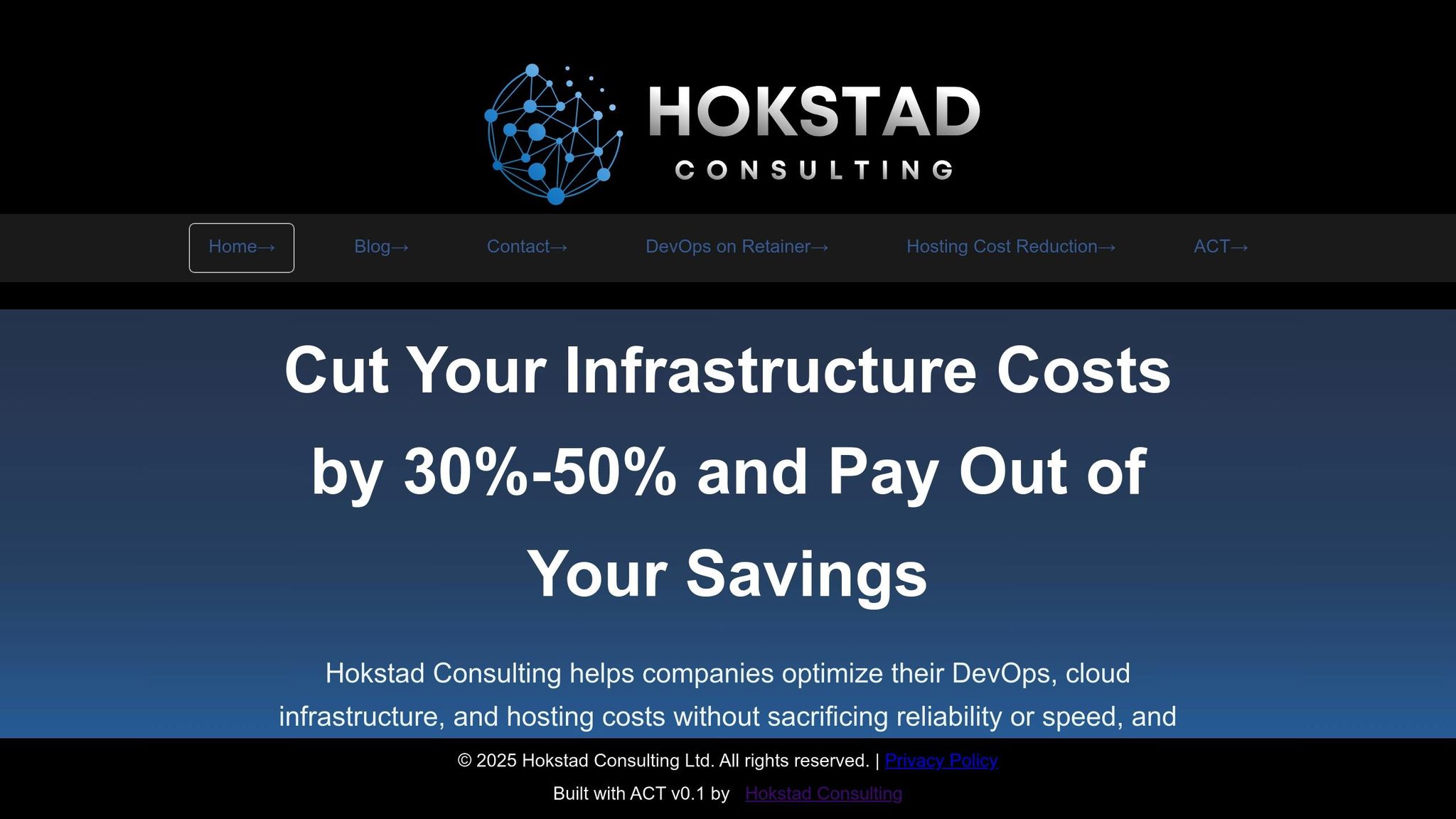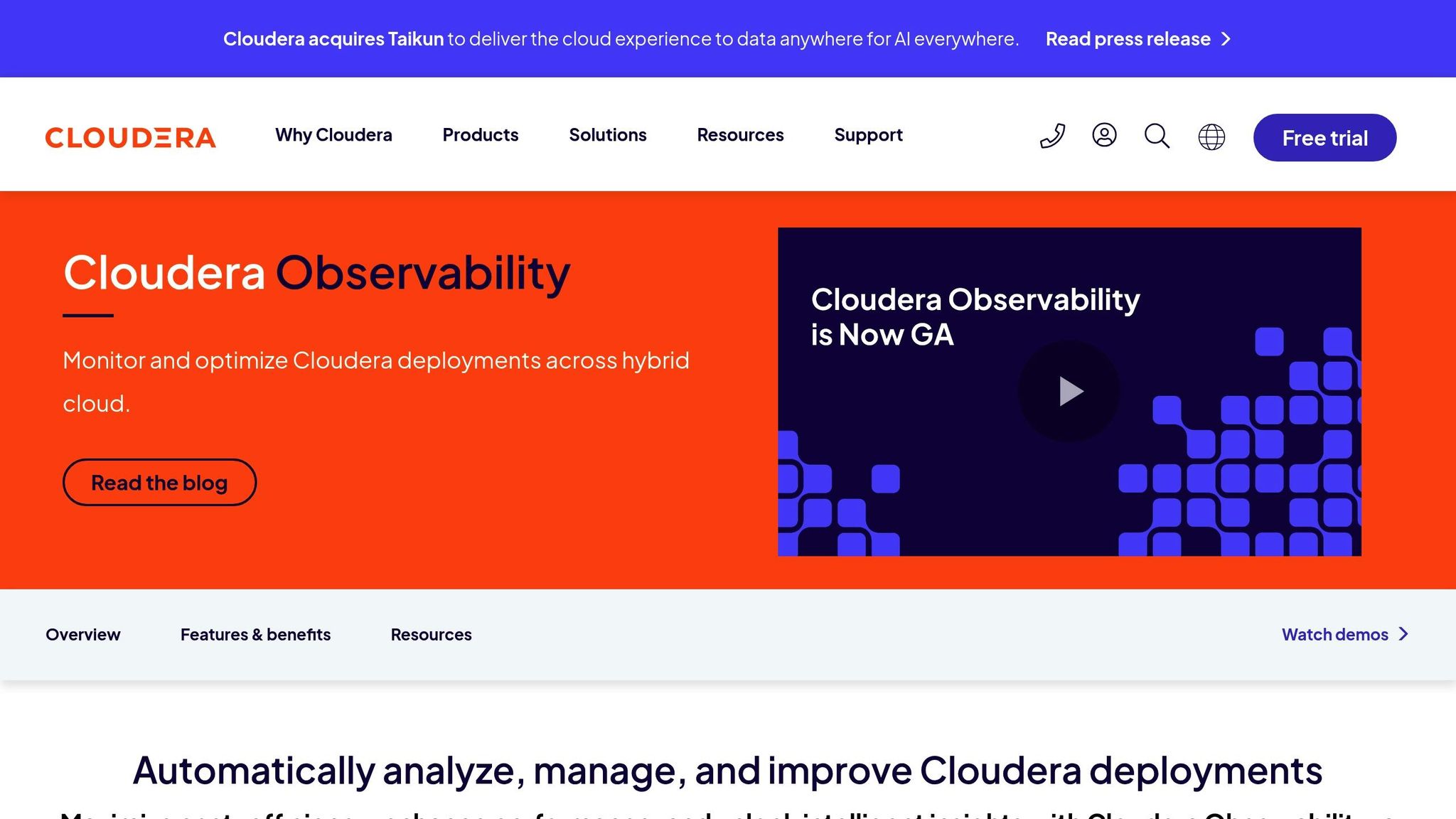Scaling private clouds efficiently requires real-time metrics. These metrics provide constant performance data, enabling organisations to adjust resources based on demand. Without them, businesses risk over-provisioning, wasting money, or under-provisioning, causing performance bottlenecks.
This article examines three solutions that use real-time metrics to optimise private cloud scaling:
- Hokstad Consulting: Focuses on cost reduction (up to 50%) and tailored automation.
- Datadog: Offers broad monitoring across systems with predictive tools to manage resources.
- Cloudera Observability: Specialises in data-heavy workflows, improving resource use and efficiency.
Each option has unique strengths, whether your priority is cost savings, system-wide monitoring, or managing data workflows effectively. Read on to see how these solutions compare and which might suit your needs.
Discover OpenStack's nerve with oslo.metrics: Have a robust private cloud on a large scale

1. Hokstad Consulting

Hokstad Consulting combines real-time performance monitoring with cost-saving strategies and efficient DevOps practices to help businesses scale effectively without overspending. Instead of just offering monitoring tools, they focus on creating sustainable systems that reduce operational costs while maintaining high performance. This approach aligns with the growing demand for smarter private cloud management.
Real-Time Data Capabilities
Hokstad Consulting integrates real-time monitoring directly into their DevOps workflows, building automated CI/CD pipelines that adapt to performance data in real time. Their system is designed to continuously monitor and adjust resources based on current demand, preventing issues before they arise.
They use caching and offloading solutions to avoid bottlenecks, monitoring everything from network traffic to storage usage and application performance. By analysing this data in real time, their systems can predict when additional resources are needed and scale automatically during peak usage.
To make this process user-friendly, they develop custom dashboards that consolidate critical metrics like CPU usage, memory consumption, and network throughput. These dashboards give infrastructure teams instant access to actionable insights, enabling quick decision-making.
Cost Optimisation Impact
Hokstad Consulting’s approach doesn’t just enhance performance - it also delivers major cost savings. By leveraging real-time metrics, they can reduce cloud expenses by up to 50%. Their cloud cost engineering services pinpoint over-provisioned resources and eliminate unnecessary spending.
Their No Savings, No Fee
pricing model highlights their confidence in achieving tangible results. Clients only pay a portion of the actual savings generated, ensuring the consultancy’s goals align with the client’s financial interests. This setup encourages aggressive cost-cutting while safeguarding budgets.
Real-time cost monitoring is central to their strategy, identifying spending inefficiencies alongside performance data. Their systems automatically scale resources down during off-peak hours, ensuring businesses only pay for what they use.
Ease of Integration
Hokstad Consulting ensures smooth integration of their monitoring systems by embedding real-time metrics capabilities into the infrastructure from the start. Their cloud migration services are designed to build these features into the foundation, avoiding the pitfalls of retrofitting systems later.
They offer flexible project and retainer options, allowing organisations to adopt real-time monitoring at their own pace. Teams can start with essential systems and expand as they grow more comfortable with the technology.
To ensure long-term value, Hokstad Consulting provides ongoing support, including regular security checks and performance updates. This proactive approach ensures that monitoring systems stay relevant and effective as infrastructure evolves, avoiding the risk of outdated tools losing their usefulness over time.
2. Datadog
Datadog offers a powerful platform for monitoring infrastructure, delivering real-time alerts and detailed performance metrics across private cloud environments. By gathering data from servers, containers, and applications, it provides live updates that help organisations maintain optimal performance.
Real-Time Data Capabilities
Datadog is designed to handle large-scale private cloud setups, making it ideal for enterprises. It supports distributed tracing, allowing teams to track service interactions and spot performance issues. The platform uses anomaly detection algorithms to learn typical behaviour and flag unusual activity, which is particularly useful in microservices architectures. This ensures that performance bottlenecks are identified quickly.
Additionally, its synthetic monitoring feature simulates user actions to detect performance issues before they affect real users. These tools not only improve performance tracking but also help organisations make smarter decisions about resource management.
Cost Management Benefits
Datadog helps businesses optimise costs by identifying underused resources based on actual usage data. Teams can monitor custom metrics alongside traditional performance indicators, ensuring resources are allocated efficiently. Integrated log management tools help uncover cost-related issues, such as memory leaks or inefficient database queries. The platform also includes forecasting features, which predict future resource needs and allow teams to plan for peak periods. This proactive approach ensures timely scaling and avoids unnecessary expenses.
Easy Integration
Datadog’s integration capabilities make it a flexible choice for organisations. Its agent-based system is quick to install and automatically detects services, reducing setup time. With an API-first approach, it supports custom integrations for unique applications or infrastructure setups.
It also works seamlessly with popular tools like Terraform and Ansible, enabling Infrastructure as Code deployments that include monitoring configurations. Role-based access controls further enhance its usability, allowing organisations to align monitoring access with their existing security policies while ensuring teams see only the data relevant to their roles.
Need help optimizing your cloud costs?
Get expert advice on how to reduce your cloud expenses without sacrificing performance.
3. Cloudera Observability

Cloudera Observability stands out by using real-time metrics to fine-tune resource allocation and scaling in private cloud environments. It caters specifically to data-heavy operations, offering detailed insights into data workflows and their resource usage.
Real-Time Data Capabilities
Cloudera Observability keeps a close watch on complex data workflows across distributed systems. It monitors job execution times, tracks data lineage, and evaluates resource usage at the cluster level. These insights help teams assess workflow efficiency and understand how data processing impacts system performance.
The platform also provides real-time tracking of query performance, pinpointing slow jobs that consume excessive resources. It delivers detailed metrics on CPU, memory, and storage usage for individual workloads. This level of detail is especially helpful for organisations using frameworks like Apache Spark or Hadoop.
With its workload intelligence feature, Cloudera analyses historical data to predict future resource needs. It identifies typical job schedules and capacity requirements, helping teams plan for peak processing times. This predictive approach not only prevents resource conflicts but also ensures critical tasks get the resources they need. These insights contribute to better performance monitoring and help refine cost management strategies.
Cost Optimisation Impact
Cloudera Observability goes beyond performance monitoring to address cost management. It identifies underused clusters and suggests ways to reduce their size or consolidate workloads, cutting down infrastructure expenses. By comparing actual resource consumption to allocated capacity, it highlights safe opportunities for cost-saving adjustments.
The platform also includes cost attribution tools, linking resource usage to specific business units or projects. This allows organisations to see which activities are driving costs and make smarter resource allocation decisions. Alerts can be set up to notify teams when workloads exceed predefined cost thresholds, helping to avoid unexpected expenses.
Another benefit is its ability to detect inefficient queries or resource-heavy data jobs. By flagging these bottlenecks, Cloudera enables teams to optimise their processes and reduce overall infrastructure demands.
Ease of Integration
Cloudera Observability integrates seamlessly with existing Cloudera setups, requiring minimal configuration. Lightweight agents are installed to automatically discover and monitor data services without disrupting ongoing operations.
For organisations using hybrid environments, the platform offers monitoring across both on-premises and cloud deployments. It provides a unified view of data activities, regardless of whether they run on Amazon EMR, Azure HDInsight, or Google Dataproc.
With its REST APIs, Cloudera Observability allows custom integrations with existing tools and dashboards. Teams can extract monitoring data to use in their preferred visualisation tools or set up automated alerts. This flexibility ensures the platform blends into established workflows without forcing teams to overhaul their processes.
Comparison Analysis
When it comes to scaling private clouds, each platform brings its own strengths, allowing organisations to choose a solution that aligns with their specific goals.
Hokstad Consulting stands out for its tailored approach, helping organisations cut cloud costs by 30–50% through strategic planning and customised automation. However, the highly personalised nature of its service may mean a longer initial setup compared to more automated solutions.
Datadog offers a unified monitoring system that spans multiple cloud providers and on-premises setups. By treating cloud usage and costs as measurable metrics, Datadog enables teams to analyse spending patterns effectively. This makes it particularly useful for managing complex environments[1].
Cloudera Observability is tailored for organisations handling large-scale data processing. Its focus on monitoring performance within Cloudera-based ecosystems ensures efficient resource utilisation, making it ideal for data-intensive operations.
| Criteria | Hokstad Consulting | Datadog | Cloudera Observability |
|---|---|---|---|
| Real-Time Data Capabilities | Custom dashboards with business-critical KPIs | Unified monitoring across cloud and on-premises | Performance monitoring for data-heavy workflows |
| Cost Optimisation Impact | 30–50% cost reduction through tailored strategies | Trackable metrics for spending analysis | Efficiency improvements in data processing |
| Ease of Integration | Requires consultation, ensuring zero-downtime migrations | Pre-built integrations for quick deployment | Seamless integration with Cloudera environments |
These comparisons highlight how each platform supports different operational needs, whether through custom strategies, broad monitoring capabilities, or data-centric insights.
Cost optimisation is a key differentiator. Hokstad Consulting delivers significant savings through its bespoke approach, while Datadog provides continuous monitoring to help teams identify cost trends. Cloudera Observability, on the other hand, focuses on improving the efficiency of data-heavy operations, which can indirectly reduce costs.
Integration ease also varies. Datadog offers rapid deployment thanks to its extensive library of pre-built integrations, making it suitable for diverse environments. Cloudera Observability is best suited for organisations already using Cloudera platforms, while Hokstad Consulting aligns closely with existing workflows through its consultative approach.
In terms of scalability, Hokstad Consulting zeroes in on business-critical metrics, Datadog provides visibility across complex systems, and Cloudera Observability ensures efficient data workflows.
Each solution leverages real-time metrics to optimise private cloud environments. Organisations aiming for maximum cost savings through a tailored strategy might lean towards Hokstad Consulting. Those needing broad, cross-platform monitoring should consider Datadog, while businesses with substantial data-processing needs may find Cloudera Observability the best fit. Across the board, timely data remains central to scaling and optimising private clouds effectively.
Conclusion
Real-time metrics play a key role in ensuring smooth and efficient private cloud scaling.
Hokstad Consulting offers customised strategies that can help businesses achieve noticeable cost reductions. Meanwhile, Datadog stands out by providing an all-in-one monitoring solution that spans both cloud and on-premises systems. This level of visibility allows teams to keep a close eye on cloud usage and associated costs.
On the other hand, Cloudera Observability takes a more specialised approach, focusing on data-centric operations. Its emphasis on monitoring performance within data-driven workflows ensures operational efficiency for businesses where data processing is a critical component of their success.
FAQs
How do real-time metrics help optimise costs in private cloud environments?
Real-time metrics are essential for managing costs effectively in private cloud systems. They provide instant feedback on how resources are being used, making it easier to spot inefficiencies like over-provisioned services or resources that aren't being fully utilised. With this information, organisations can take swift action to address these issues.
By supporting continuous monitoring and enabling dynamic scaling, real-time metrics ensure that resources are used wisely, cutting down on wasteful spending. The result? Lower costs and better returns from your cloud infrastructure.
How does Hokstad Consulting's approach to scaling private clouds differ from other common strategies?
Hokstad Consulting takes a forward-thinking approach to scaling private clouds by leveraging machine learning and AI-driven workload optimisation. This enables them to predict demand and craft customised, cost-effective strategies for hybrid environments. Their method prioritises cutting costs without compromising on performance or scalability.
Unlike other approaches that rely heavily on real-time monitoring and focus on operational visibility, Hokstad stands out by predicting and fine-tuning workloads ahead of time. This ensures resources are allocated efficiently, reducing waste and improving overall effectiveness.
How can organisations seamlessly integrate real-time metrics into their private cloud infrastructure?
To successfully incorporate real-time metrics into private cloud infrastructure, organisations should rely on a centralised monitoring solution. This type of system can handle a variety of data sources, including cloud platforms, container services, and APIs, bringing all critical performance data together in one place for easier oversight and management.
It's also crucial to regularly review and adjust monitoring parameters to ensure the metrics remain relevant and useful. Incorporating automation into the process can make a big difference, simplifying data collection and processing. This frees up teams to focus more on interpreting the data and making informed decisions.
Using tools that combine metrics, logs, and traces in real time can significantly boost operational responsiveness. This approach helps organisations adapt quickly and ensures their private cloud infrastructure scales effectively to keep up with business needs.
